The new approach to garden weeds and why you need it
Garden designer and writer Jack Wallington believes that many common garden weeds can add to the beauty of your garden. You don’t need to spend hours weeding them all out.

With Jack Wallington in his jungly Clapham garden. You can just see the distinctive fronds of Ricinus communis, which is considered a noxious weed in some countries….
His book, Wild About Weeds – Designing with Rebel Plants, published by Laurence King Publishing, aims to change our attitudes to them. And this also makes weeding easier and more rewarding.
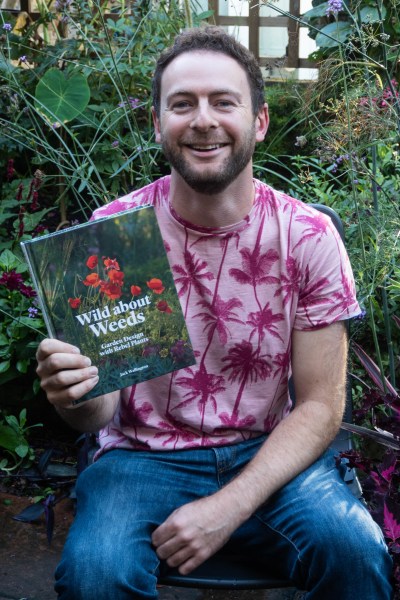
Jack Wallington and Wild About Weeds – Designing with Rebel Plants
Personally, I have a lot of weeds in my own garden. I love self-seeded plants. They add colour and life, especially in early and mid summer.
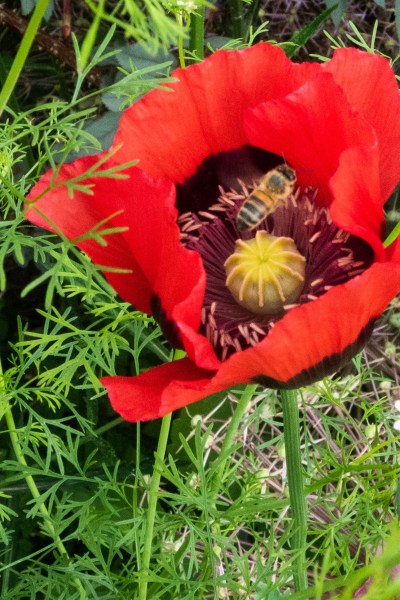
Self seeded flowers, wild flowers and garden weeds in the Middlesized Garden – they’re brilliant for wild life.
But that’s because I don’t do as much weeding as I should. The two are directly connected. An easy, relaxed, colourful garden full of self-seeded flowers will also be full of common garden weeds. If you are tidy and diligent about weeding, you’re unlikely to get many self-seeders. I secretly admire the diligent weeders because I suspect that once they get the weeding under control, they probably need to do less work.
And at certain times of year, my garden does look very tatty and weed filled. So I was interested to see how Jack’s approach could help reduce weeding and help the garden look better.
A new trend towards common garden weeds?
Wild About Weeds was published at a good time. This year, I saw both nettles and buttercups in show gardens at the RHS Chelsea Flower Show – not for the first time. James Basson’s Maltese Quarry garden won Best in Show in 2017 and it incorporated many plants that are considered weeds.
I enjoyed contrasting the immaculately manicured buttercups and long grass in the David Harber garden at RHS Chelsea Flower Show 2019 with the same long grass and weeds effect in my garden.
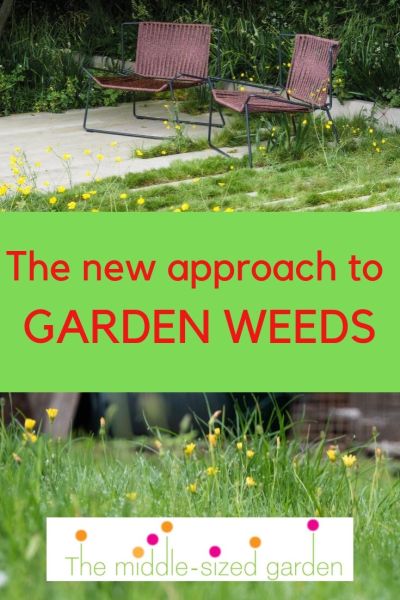
The top photo is of the David Harber garden at the 2019 RHS Chelsea Flower Show. The photo below it is my lawn. I haven’t quite got the look…but it’s worth thinking about.
The trend towards planting mini wildflower meadows is also still growing, even in very small gardens. And there is a very narrow divide between weeds and wildflowers.
And I’ve seen ‘weeds’ in some of the best gardens in the UK. For example, when I visited Gravetye Manor this May, I saw herb Robert, red Valerian and yellow corydalis growing into the crevices of garden steps. They looked wonderful.
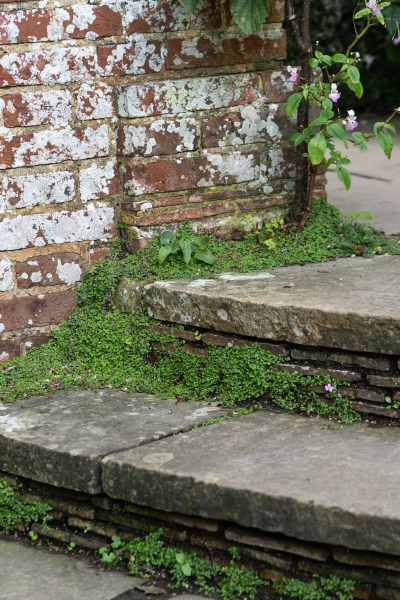
Steps at Great Dixter. Mind-Your-Own-Business should be issued with a health warning as it is very invasive. But it’s prettier than alot of the weeds that spring up in cracks.
And at Great Dixter, there is Mind-Your-Own-Business (Soleirolia soleirolii) growing into the crevices of steps.
In Jack’s own garden, he has ivy, toadflax, moss and caper spurge, along with the Castor Oil Plant (Ricinus communis) which is considered a noxious weed in many countries.
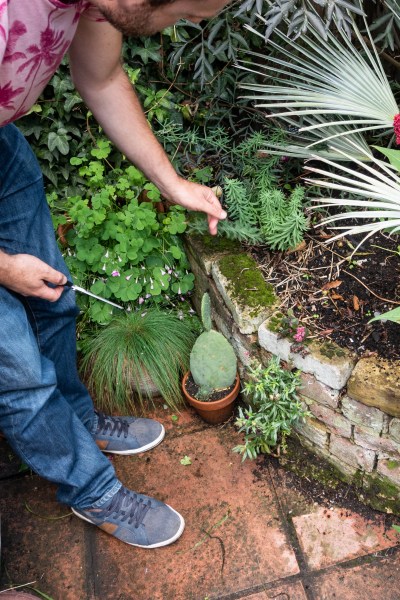
Toadflax, wood sorrel, moss and snapdragons nestling in a corner of Jack’s Clapham courtyard garden.
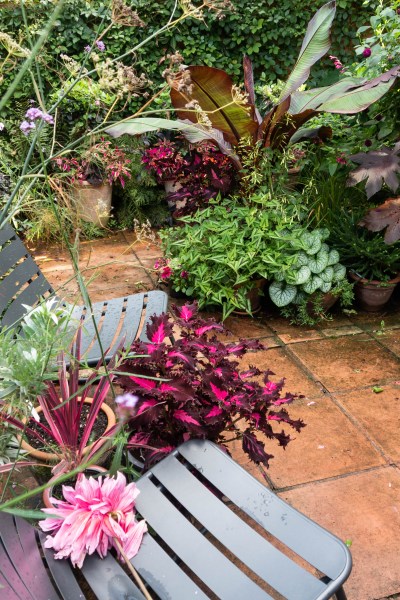
Jack’s garden not focussing on weeds…he has wonderfully jungly effects with contrasting foliage and uses big statement plants for impact.
So how can common garden weeds help improve your garden?
In Wild About Weeds, Jack makes the point that you can encourage less invasive and more attractive weeds to colonise your garden. And eventually they should out-compete the weeds you really don’t want.‘Fight weeds with weeds,’ he says. If you have good ground cover then weeds can’t pop up so easily.
I have really noticed this in my garden – in the bed where plants grow well, I have virtually no bindweed. But the next border is heavily shaded by a tree and very little thrives there. So it is often blanketed by bindweed. Jack suggests I try out-competing the bindweed with herb Robert, ivy and caper spurge.
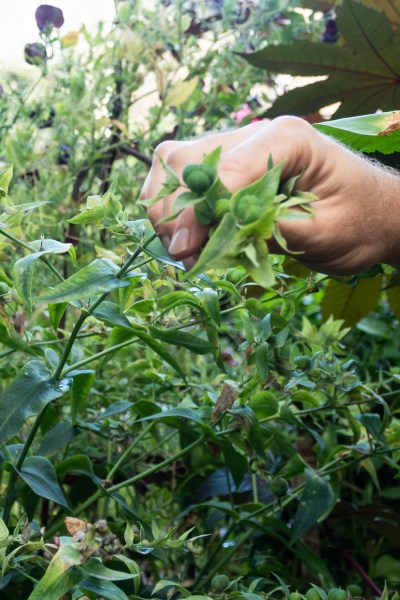
Caper spurge, the wild form of euphorbia, in Jack’s garden. It has an interesting flower shape and could out-compete the bindweed in my shady border.
The bad weeds…
Wild About Weeds names around half a dozen weeds that you will have to weed out of your garden, with pictures so you can identify them. They include bindweed, ground elder, couch grass, green alkanet and of course Japanese knotweed.
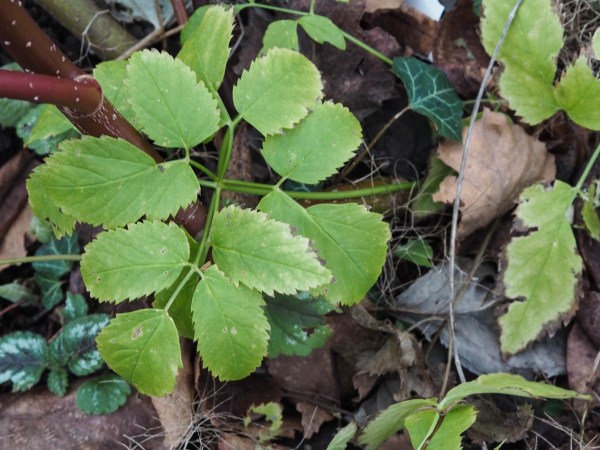
Ground elder in my garden. Plus ivy and dead nettle (lamium).
Jack recommends hand weeding, because you can dig the roots out with a fork. And that won’t disturb the plants around the weed as much as spraying would. Or if you have a large area with, for example, ground elder, you can also cover it with a light excluding material, such as cardboard.
Find out how different garden experts weed their gardens in the No-Nonsense Guide to Weeding Your Garden here.
And the good weeds…
Jack points out that the definition of a weed varies from person to person. Some people consider forget-me-nots, dog roses, everlasting sweet peas and buddleias to be weeds but others don’t. Attractive ‘weeds’ can include dead nettles (Lamium). ‘If you get nettles, then you can get rid of them by weeding them out, then replacing them with lamium/dead nettles which can be very attractive. And eventually the Lamium will take over and provide the ground cover that stops the nettles from re-establishing themselves, he says.
Here in East Kent, we get wild salsify drifting in from the marshes. We rarely pull it out because it’s beautiful. If a plant is attractive to us and does well, especially in a difficult spot, then our gardening lives will be much easier if we let it grow.
Wild About Weeds lists various weeds and where they do well – ‘Weeds for Shady Borders’ suggests caper spurge, herb Robert, stinking iris, white deadnettle and Welsh poppy, for example. Weeds for Ground Cover (think of those bleak areas under trees…) include sweet violet, lesser celandine, purple wood sorrel and ivy.
See more on video:
How to get weeds into your garden…
The idea of getting the right weeds into your garden might sound bizarre. Jack suggests you start by seeing which weeds you like in your garden, and just letting them grow.
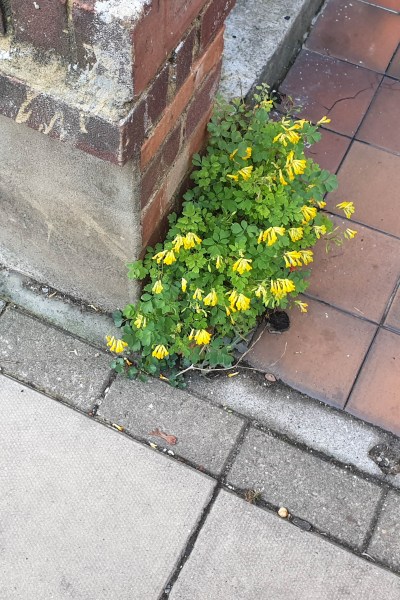
You’ll be amazed by the number of weeds you can spot growing in cracks and crevices around town. It’s a real testament to the resilience of plants. This is yellow corydalis.
Or you could look out for weeds growing locally. Then you can collect the seed or prise them out of where they are growing. Jack and I went weed-hunting on the streets of Clapham where he lives. Many plant experts advise you to learn about plants by seeing them in the wild. And seeing how weeds develop in cities and towns is seeing plants grow in the wild. But that doesn’t have to mean seeing wild orchids in India and China. It can also mean spotting weeds in Clapham.
So Wild About Weeds is a book that will teach you more about plants generally, not just about weeds.
You can also contact companies that sell wildflower seeds to see if they have some seeds. For example, you can get seeds for yellow rattle and cornflowers on Amazon, along with wildflower mixes.
And there’s a company called Justseed which sells seeds for red and purple dead nettles, dandelions and wild chicory.
For more about gardens where weeds are allowed (even enjoyed), see this post.
More about Wild About Weeds
Wild About Weeds by Jack Wallington is published by Laurence King Publishing (£19.99).
I’ve also added it to my list of favourite gardening books, available on Amazon. I’m often asked for recommendations, so I’ve made lists of the products, books and tools I really like on the Middlesized Garden Amazon store. If you’re in the US, this is the Middlesized Garden Amazon store. (note that links to Amazon are affiliate, so I may get a small fee if you buy, but it doesn’t affect the price you pay.)
Pin to remember new ways with weeds
And do join us for a free weekly email with more tips, ideas and inspiration for your garden.
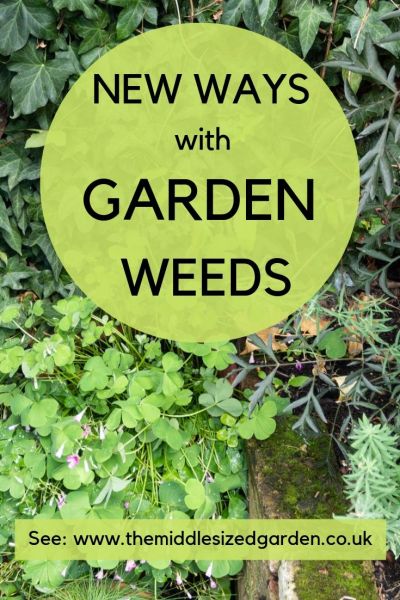
























Shame ground elder is shamed. I have a bed of it and if I showed you a picture, (I can’t here, sadly) you would want one too. Great flowers, classy leaf, good plant. See also https://www.telegraph.co.uk/gardening/gardens-to-visit/weeding-living-weeds-can-make-us-better-gardeners/
Xxxxx
I have so much of it that it’s hard to love it. But I take your point about both the leaf and the flower…shall I leave it in? I suspect that I would wake up one morning smothered by it if I did…
Celandine is a lovely ‘weed’ that dies right back by the time early summer arrives. We have a lot of red dead-nettle and herb robert, both of which need controlling, but are easily pulled up if they get too invasive. All the toadflax forms are lovely plants, and woodruff is a great colonizer.
I love woodruff and celandine. Even the names are beautiful. And toadflax potters about my garden, getting stuck in where nothing else wants to grow.
I have this plant Celandine. I don’t love it. I have lovely weeds in my garden but this Celandine is invasive and bulbs all over the grass and garden. We made a concerted effort digging it out and if one bulb is left it will grow like wildfire to take over your garden.
I have weeds like that, too.